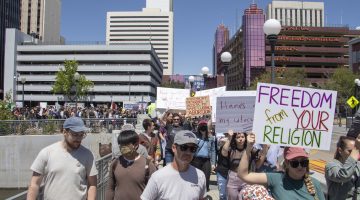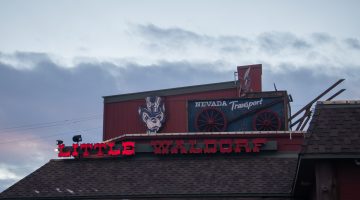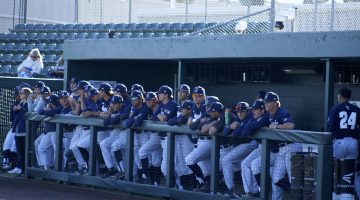 As a German immigrant to the Nevada area in 1935, it is believed that artist Hans Meyer-Kassel found refuge and solace in the western Sierra landscape. Having served and survived injury on Germany’s front lines during World War I, Meyer-Kassel emigrated from his native country during the time that Adolf Hitler and the Nazi party were rising to power in Germany.
As a German immigrant to the Nevada area in 1935, it is believed that artist Hans Meyer-Kassel found refuge and solace in the western Sierra landscape. Having served and survived injury on Germany’s front lines during World War I, Meyer-Kassel emigrated from his native country during the time that Adolf Hitler and the Nazi party were rising to power in Germany.
The artist was visiting the west coast of the U.S. while exhibiting in Pasadena, California when he first visited Reno. Once in Reno, he sent for his wife and they never looked back.
The couple lived in an apartment in the downtown area at 228 Virginia Street, right below the Nevada Club. The scene from their apartment window during the Reno Rodeo was painted by Meyer-Kassel and is currently displayed at the Nevada Museum of Art. His nostalgic painting’s neon signs lighting up a dark Virginia Street is an all-too-familiar scene for Reno and is successful at taking you back in time while preserving the image of downtown Reno that we’re all familiar with.
While Meyer-Kassel and his wife undoubtedly loved the western Nevada region, they struggled through the Great Depression in Nevada. Moreover, it was from Reno that the artist had to watch the destruction of Munich and Kassel, two of the most influential and foundational cities in regards to his education and artistic identity.
There are a select few paintings of the artist’s that stray from his usual and comfortable landscape and portrait themes and focus on the social turmoil the artist witnessed during his lifetime. These uncharacteristically challenging portraits depict demons, other mythical creatures and general destruction and confusion.
Jack Bacon, a Reno local, art appraiser and co-curator for the current Hans Meyer-Kassel exhibit, explains in his book on the artist that it is no surprise Meyer-Kassel settled in Genoa for the last six years of his life, suggesting it was a source of spiritual rest for the artist after living through the Great Depression and both World Wars.
This rest can be perceived through his paintings that depict varied western Nevada areas like Pyramid Lake, the Carson Valley, Lamoille Canyon, Zephyr Cove, etc. When compared to his earlier work following the World Wars and the Great Depression, there is a noticeably greater sense of serenity and stillness. Whether or not his time living in Nevada contributed some spiritual or psychological healing to the artist was never expressed in words that still exist, but one can take a look at his body of work and sense the greatness it could have held for Meyer-Kassel.
Before immigrating to the U.S., Meyer-Kassel was born in Kassel, Germany. He received academic training in art from the University of Munich after abandoning a pragmatic decision to study law at the University of Leipzig. “Ever since I was a boy, I wanted to be a painter,” he told Amherst College Collegian newspaper in 1933.
In Munich, Meyer-Kassel developed a “late Impressionist” artistic identity that has now defined his life’s work. He flourished as an artist and, when he wasn’t busy establishing his own artistic unions and organizations, he actively participated in various others throughout Munich.
Meyer-Kassel had become so celebrated by his German community that his native city granted him the honor of adding the city’s name to his own, which Meyer-Kassel happily adopted before immigrating to the United States.
While the artist’s work was primarily done in oils, Meyer-Kassel also worked with pastels and tempera from time to time. At his posthumous exhibit currently on display at the Nevada Museum of Art, it is Meyer-Kassel’s landscape paintings, including some of Germany, but mostly Nevada, that conquer the gallery.
Besides landscapes, Meyer-Kassel championed his still-life paintings and was regularly commissioned, both in Germany and the United States, to paint portraits of government and military officials.
It is the German artist’s portrait of Clarence Mackay that hangs in the Mackay Science Hall at UNR. He also left Reno with portraits of past governors, like the late Governor Vail Pittman, that still live in Carson government offices to this day.
The artist’s sketch of a log cabin in the Genoa pines was also notably chosen among other contestants to be the second United States commemorative postage stamp in 1951, celebrating 100 years of settlement in Genoa.
Meyer-Kassel’s postage stamp was widely celebrated throughout Nevada, receiving praise from the assistant postmaster general, Nevada Governor Russell, and Senator McCarran.
The New York Times described the stamp in a June 10 edition: “Based on a sketch by Hans Meyer-Kassel, a Genoa artist, the vignette shows a log cabin at right, a tall pine at left. Between are a campfire, wagon, men and animal. This pioneer scene in the Carson Valley of a century ago is set against the snow topped Sierra Nevada Mountains rising in the distance.”
A year before leaving Germany in 1921, Meyer-Kassel met his wife, Maria Magdalena Hesse, who was a children’s nurse in a home on an estate he visited after he was commissioned to paint portraits of a general’s family. Years later in 1932, he would tell a reporter for the Brooklyn Daily Eagle, “Not one day could I live without my wife.”
The following year, Meyer-Kassel and his new wife had arrived at Ellis Island in New York, where Meyer-Kassel had to reinvent his career as an artist. After traveling back and forth between the United States and Iceland for a few months, the artist’s work of these trips began gaining recognition from museums in New York and The New York Times art critics.
According to what we know about the artist today, Meyer-Kassel truly dedicated his life to his artwork. On August 29, 1952, Meyer-Kassel finished a portrait and laid aside his brushes to take a nap before returning to his work on an unfinished painting of the Carson Valley. The artist never woke from his nap and died the next morning, leaving Nevada with an impressive and powerful body of work that continues to hang in private homes, government buildings and our university.










